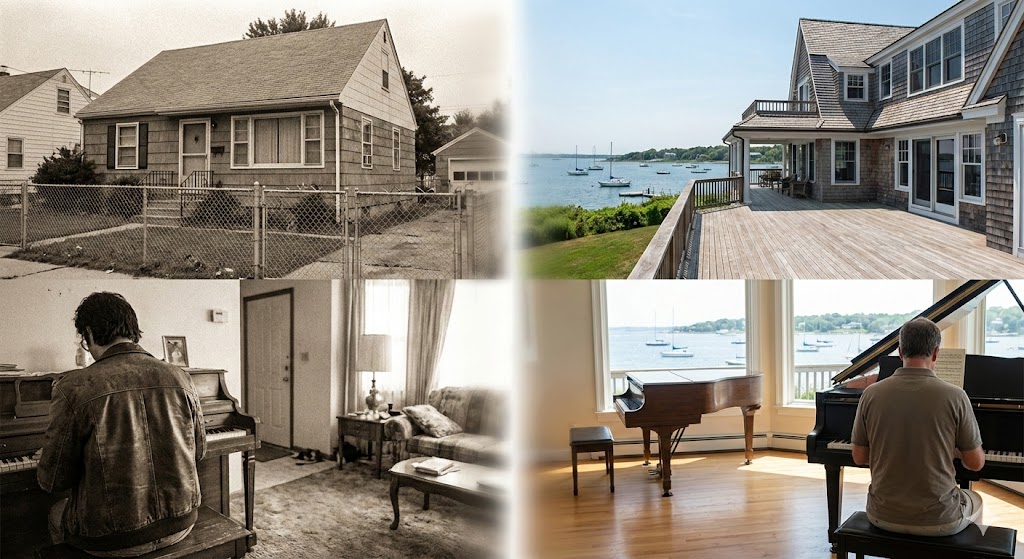The old money aesthetic isn’t purchased—it’s cultivated. While new money screams through logos and trends, old money whispers through quality and restraint. INSEAD research reveals that luxury consumers balance two conflicting motives: differentiation and assimilation with elite groups. Moreover, the old money aesthetic solves this tension by signaling status only to those who matter—the ones who recognize Loro Piana cashmere without seeing a logo.
This phenomenon has exploded across social media, generating billions of views. However, achieving authentic old money style requires understanding principles that wealthy families have practiced for generations. The aesthetic transcends mere clothing choices. It represents an entire philosophy about quality, longevity, and effortless sophistication that money alone cannot buy.
Understanding the Old Money Aesthetic Philosophy
The old money aesthetic operates on principles fundamentally different from conspicuous consumption. According to BCG research, modern luxury consumers embrace temperance, slow fashion, and inconspicuousness. This shift reflects deeper psychological motivations beyond simple wealth display. Additionally, the aesthetic embodies inherited values rather than acquired status, creating distinction through cultural capital instead of price tags.
Traditional old money families built wealth over generations. Consequently, they developed distinctive approaches to dress, behavior, and lifestyle. These families value discretion, viewing overt displays of wealth as gauche or insecure. Furthermore, their style evolved from practical needs—durable clothing for country estates, classic pieces for social events, quality fabrics that last decades.
The Psychology Behind Quiet Luxury
Research into luxury consumption reveals fascinating insights about the old money aesthetic. Studies published in Psychology & Marketing found that quiet luxury buyers seek connection with elite groups who share similar values. This contradicts classic theories suggesting luxury exists solely for mass status signaling. Instead, old money style functions as in-group identification—a secret handshake recognizable only to fellow insiders.
The satisfaction comes from knowing rather than showing. When someone wearing a $3,000 Brunello Cucinelli cashmere sweater passes unnoticed by most but receives a knowing nod from another connoisseur, that subtle recognition provides deeper satisfaction than widespread attention. Moreover, this dynamic creates psychological distance from “new money” ostentation while reinforcing membership in exclusive social circles.
Cultural Capital Over Financial Capital
The old money aesthetic prioritizes cultural knowledge over pure spending power. Understanding which brands represent true quality, recognizing subtle craftsmanship details, and knowing appropriate attire for specific contexts all demonstrate cultivation that money alone cannot purchase. Additionally, this knowledge gets transmitted through families, private schools, and exclusive social networks rather than purchased at retail.
This creates barriers to entry beyond financial resources. Someone could buy an entire wardrobe of correct pieces without understanding how to wear them appropriately. The confidence, ease, and natural integration of classic style require socialization into environments where these standards exist as unspoken rules.
Essential Elements of Old Money Style
Building an old money aesthetic wardrobe requires strategic focus on specific elements. Quality always trumps quantity. Harvard Business School research demonstrates how endless fast-fashion cycles create pressure for unrelenting growth and waste. Conversely, investing in fewer, superior pieces aligns with both financial wisdom and environmental consciousness.
The foundation consists of timeless neutrals—navy, cream, camel, charcoal, and white. These colors work across seasons and occasions while projecting understated sophistication. Furthermore, neutral palettes simplify daily dressing while ensuring everything coordinates effortlessly. Bold colors and patterns appear sparingly, typically in accessories or specific contexts like sporting events.
Fabric Quality and Natural Materials
Old money style demands specific materials. Cashmere, silk, cotton, wool, linen, and leather form the fabric foundation. These natural materials breathe, age gracefully, and feel luxurious against skin. Moreover, they signal quality through texture and drape rather than labels or logos. Synthetic fabrics, particularly polyester and acrylic, rarely appear in authentic old money wardrobes.
The difference becomes immediately apparent in person. A $400 cotton Oxford shirt from Brooks Brothers feels completely different from a $40 polyester version. The weight, hand-feel, and way fabric moves all communicate quality without words. Additionally, natural fabrics develop character through wear—leather patinas, linen softens, cashmere becomes more supple—while synthetics simply deteriorate.
Tailoring and Perfect Fit
Off-the-rack pieces rarely fit perfectly. Consequently, tailoring represents non-negotiable investment in the old money aesthetic. Proper sleeve length, appropriate trouser breaks, and precise shoulder fit transform good pieces into great ones. Furthermore, tailoring extends garment lifespan by ensuring comfort and proper wear patterns.
Expert tailoring costs less than most assume. Basic alterations—hemming trousers, adjusting sleeve length, suppressing waists—typically run $20-60 per garment. However, this investment dramatically elevates appearance. A $200 blazer tailored perfectly looks superior to a $2,000 blazer worn off the rack.
Building Your Old Money Wardrobe
Creating an old money aesthetic requires systematic approach rather than random purchases. Start with versatile foundations that work across multiple contexts. Additionally, prioritize pieces you’ll wear frequently over statement items used occasionally. The goal is a cohesive capsule wardrobe where everything coordinates seamlessly.
Investment pieces form the wardrobe core. For men, this includes navy blazers, Oxford cloth button-downs, quality leather loafers, cashmere sweaters, and well-fitted chinos. Women need tailored blazers, silk blouses, quality leather handbags, classic pumps, cashmere cardigans, and well-cut trousers. Moreover, these pieces should be classic enough to remain stylish for decades.
Strategic Brand Selection
Certain brands authentically embody old money aesthetic while others merely approximate it. Ralph Lauren pioneered accessible old money style, making preppy sophistication available beyond exclusive circles. Brooks Brothers, established in 1818, represents American old money heritage. Additionally, Loro Piana, Brunello Cucinelli, and The Row offer contemporary interpretations of quiet luxury principles.
European heritage brands like Hermès, Burberry, and Barbour bring centuries of craftsmanship tradition. However, brand selection requires nuance. Gucci’s recent collections lean toward conspicuous consumption rather than old money restraint. Similarly, Louis Vuitton’s logo-heavy pieces contradict quiet luxury principles despite the brand’s prestige. Research shows that luxury novices prefer loud logos while experts choose quiet pieces.
Accessible Old Money Style
Achieving the old money aesthetic doesn’t require unlimited budgets. Several strategies make the look accessible. First, prioritize quality over quantity—five excellent pieces outperform twenty mediocre ones. Second, shop secondhand for luxury brands. Platforms like The RealReal and Vestiaire Collective offer authenticated luxury at substantial discounts.
Third, invest strategically. Spend more on items worn frequently and visible to others—blazers, coats, shoes, handbags. Save on basics like t-shirts and undergarments. Fourth, maintain pieces properly. Quality garments last decades with appropriate care—dry cleaning, shoe trees, proper storage, and timely repairs extend lifespan dramatically.
Styling Principles for Effortless Elegance
The old money aesthetic appears effortless precisely because it follows specific principles. Monochromatic dressing creates sophisticated simplicity—navy blazer with navy trousers, cream sweater with cream pants. This approach projects polish while requiring minimal styling thought. Moreover, tonal dressing elongates silhouettes and appears intentional rather than matched.
Layering adds depth and sophistication. Oxford shirt under cashmere sweater under navy blazer creates visual interest while remaining understated. Additionally, proper layering demonstrates style knowledge—correct collar heights, appropriate sleeve lengths, and complementary weights all signal expertise. Accessories remain minimal but high-quality—simple watches, subtle jewelry, leather belts with brass buckles.
The Power of Restraint
What you don’t wear matters as much as what you do. Avoid visible logos except tiny emblems like Lacoste’s crocodile or Ralph Lauren’s pony. Eliminate trendy pieces that quickly date—ultra-skinny jeans, exaggerated proportions, or seasonal “it” items. Furthermore, resist the urge to accessorize heavily. One quality watch beats multiple statement pieces.
This restraint extends to grooming and presentation. Hair appears neat but natural, never overly styled. Nails stay trimmed and clean. Fragrance sits close to skin rather than announcing your presence. The overall impression should be polished effortlessness—looking put-together without appearing to have tried hard.
Context-Appropriate Dressing
Old money style adapts seamlessly across contexts. Country weekends demand different attire than city business meetings. Understanding these nuances demonstrates cultural literacy that transcends simple fashion knowledge. Barbour jackets and Hunter boots suit rural settings. Tailored suits and leather briefcases fit urban environments.
This adaptability comes from genuine lifestyle requirements rather than costume play. Traditional old money families actually spent weekends at country estates, attended yacht clubs, and participated in specific sports. Their wardrobes evolved organically from these activities. Consequently, authentic old money style reflects practical needs elevated through quality materials and expert tailoring.
Beyond Clothing: The Complete Aesthetic
The old money aesthetic extends beyond wardrobe into broader lifestyle presentation. Home environments emphasize comfort over showiness—worn leather furniture, family heirlooms, and understated art. Additionally, activities lean toward traditional pursuits—tennis, sailing, horseback riding—rather than trendy fitness classes or extreme sports.
Social behavior follows unspoken codes. Conversations avoid discussing money directly. Name-dropping appears gauche. Excessive enthusiasm seems unsophisticated. Furthermore, genuine old money families prioritize discretion in all aspects of life. Their wealth functions as quiet foundation rather than main storyline.
Digital Presence and Social Media
The old money aesthetic faces interesting challenges in digital age. Traditional discretion conflicts with social media’s performative nature. However, those embracing the aesthetic online typically share aspirational lifestyle content focused on timeless beauty rather than personal wealth displays. Moreover, accounts feature aesthetically pleasing imagery—architecture, nature, classic fashion—without constant selfies or luxury flexing.
This approach generates engagement from audiences appreciating sophistication over spectacle. The content whispers rather than shouts, attracting viewers who value refinement. Additionally, maintaining mystery and selectivity about personal life aligns with old money discretion principles while functioning effectively within digital platforms.
The Modern Evolution of Old Money Style
Contemporary old money aesthetic adapts traditional principles for modern contexts. Sustainability consciousness has strengthened rather than weakened the philosophy. Research shows 30% of affluent consumers prioritize sustainable luxury, aligning perfectly with old money emphasis on quality, longevity, and thoughtful consumption.
Younger generations reinterpret classic elements with fresh perspectives. They might pair vintage Hermès scarves with contemporary silhouettes or combine heritage brands with emerging designers focused on craftsmanship. Moreover, this evolution demonstrates that old money aesthetic isn’t about rigid adherence to outdated rules but rather about maintaining core principles while allowing appropriate modernization.
Quiet Luxury in Economic Uncertainty
Economic conditions influence luxury consumption patterns. During prosperous periods, conspicuous consumption increases—logos, bold designs, obvious wealth display. Conversely, uncertain economic times see quiet luxury resurge. Currently, brands like Brunello Cucinelli and Loro Piana thrive while logo-heavy brands struggle. This cyclical pattern reflects psychological needs for security and discretion during volatility.
The old money aesthetic offers psychological comfort during uncertain times. Its emphasis on timeless quality over trendy consumption provides both financial wisdom and emotional stability. Additionally, the restraint and understated elegance project confidence and security—valuable signals when broader culture feels anxious.
Mastering the Art of Looking Rich Without Trying
True old money aesthetic cannot be purchased overnight. It requires understanding principles, developing discernment, and cultivating confidence. However, anyone can begin building authentic personal style rooted in quality, restraint, and timelessness. Start with classic foundations, invest in tailoring, prioritize natural materials, and embrace strategic simplicity.
Remember that old money style ultimately reflects values beyond mere appearance. It represents commitment to quality over quantity, permanence over trends, and substance over flash. These principles create wardrobes that serve for decades, reduce environmental impact, and project sophisticated confidence. Moreover, they offer liberation from constant consumption cycles and trend-chasing anxiety.
The old money aesthetic whispers where others shout. It signals status through insider knowledge rather than external logos. Most importantly, it demonstrates that true luxury comes not from what you spend but from how thoughtfully you curate. In a world drowning in conspicuous consumption, quiet sophistication stands out precisely by not trying to.
Featured Opportunities
Feature Article Ideas/Advertising/Brand Partnership Inquiries – Contact Social Life Magazine
Polo Hamptons Tickets, Cabanas, Brand Sponsorships – Explore Polo Hamptons
Join Our Email List – Subscribe Now
Social Life Magazine Print Subscription – Subscribe Today
Support Independent Luxury Journalism – Donate $5 to Social Life Magazine






